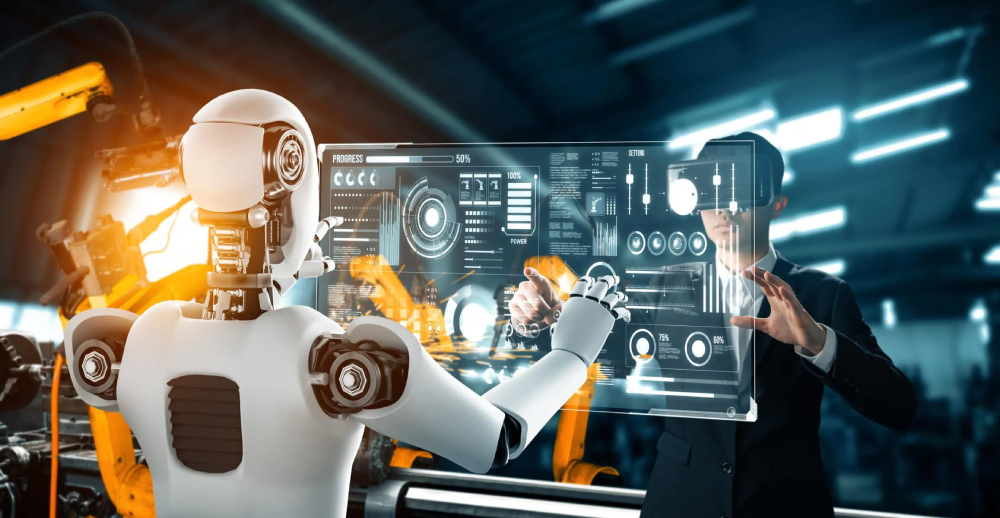AI Revolutionizing Production Planning & Control
Artificial Intelligence (AI) is transforming numerous industries, including production planning and control. AI technologies have the capacity to significantly alter traditional approaches to production management, resulting in enhanced efficiency, reduced costs, and more informed decision-making processes. By implementing AI solutions, organizations can optimize their manufacturing operations, minimize waste, and boost overall productivity.
This article examines the impact of AI on production planning and control, highlighting its advantages and addressing the challenges associated with its adoption. Furthermore, it presents case studies demonstrating successful AI integration in production environments and discusses emerging trends and future developments in this domain.
Key Takeaways
- AI is revolutionizing production planning and control by enabling more efficient and accurate decision-making processes.
- AI plays a crucial role in production planning and control by analyzing large volumes of data, predicting demand, and optimizing production schedules.
- The benefits of AI in production planning and control include improved accuracy, reduced lead times, and better resource utilization.
- Challenges and limitations of AI in production planning and control include the need for high-quality data, potential job displacement, and the complexity of implementation.
- Case studies of successful implementation of AI in production planning and control demonstrate significant improvements in efficiency, cost savings, and customer satisfaction.
The Role of AI in Production Planning & Control
Predictive Analytics and Forecasting
AI plays a vital role in production planning and control by enabling predictive analytics, real-time monitoring, and autonomous decision-making. Through machine learning algorithms, AI can analyze historical production data to forecast demand, optimize inventory levels, and schedule production activities. This predictive capability allows companies to better anticipate market trends and customer demands, leading to more accurate production planning.
Real-time Monitoring and Anomaly Detection
Furthermore, AI can facilitate real-time monitoring of production processes, detecting anomalies and inefficiencies that may require immediate attention. This proactive approach to monitoring enables companies to address issues before they escalate, minimizing downtime and maximizing productivity.
Autonomous Decision-Making and Automation
Additionally, AI can enable autonomous decision-making by integrating with production systems to automatically adjust production schedules, allocate resources, and optimize workflows based on real-time data. This level of automation can significantly improve the efficiency of production planning and control processes.
Benefits of AI in Optimizing Production Planning & Control

The implementation of AI in production planning and control brings a multitude of benefits to companies. One of the key advantages is the ability to optimize production processes through data-driven insights. By analyzing large volumes of data, AI can identify patterns and trends that human planners may overlook, leading to more efficient resource allocation and scheduling.
This optimization can result in cost savings, reduced lead times, and improved overall productivity. Additionally, AI can enhance decision-making by providing accurate forecasts and recommendations based on real-time data. This enables companies to make informed decisions that align with market demand and production capacity, ultimately leading to better resource utilization and customer satisfaction.
Furthermore, AI can improve the agility of production planning and control by enabling quick adjustments to production schedules in response to changing market conditions or unexpected disruptions. This flexibility allows companies to adapt to dynamic environments and maintain a competitive edge in the market.
Challenges and Limitations of AI in Production Planning & Control
| Challenges and Limitations of AI in Production Planning & Control |
|---|
| Lack of historical data for training AI models |
| Complexity of production processes |
| Difficulty in integrating AI with existing systems |
| Cost of implementing AI technology |
| Reliability and accuracy of AI predictions |
| Resistance to change from employees |
While AI offers numerous benefits for production planning and control, there are also challenges and limitations that come with its implementation. One of the main challenges is the need for high-quality data to train AI models effectively. Without accurate and comprehensive data, AI algorithms may produce unreliable forecasts and recommendations, leading to suboptimal decision-making.
Additionally, the complexity of AI algorithms may require specialized expertise to develop and maintain, posing a challenge for companies with limited resources or expertise in AI technologies. Furthermore, there may be resistance from employees who fear that AI will replace their roles in production planning and control. Overcoming these challenges requires a strategic approach to data management, investment in training and talent acquisition, as well as effective change management to ensure employee buy-in and collaboration with AI systems.
Case Studies of Successful Implementation of AI in Production Planning & Control
Several companies have successfully implemented AI in their production planning and control processes, showcasing the tangible benefits it brings. For example, a leading automotive manufacturer used AI-powered predictive analytics to optimize their production scheduling, resulting in a 15% reduction in lead times and a 10% increase in overall equipment effectiveness. By leveraging AI algorithms to analyze historical production data and market demand, the company was able to improve resource utilization and minimize production bottlenecks.
Similarly, a consumer goods company implemented AI-based real-time monitoring to detect anomalies in their production processes, leading to a 20% reduction in downtime and a 5% increase in production yield. These case studies demonstrate the potential of AI to drive significant improvements in production planning and control across various industries.
Future Trends and Developments in AI for Production Planning & Control

Autonomous Decision-Making at the Edge
One emerging trend is the integration of AI with Internet of Things (IoT) devices to enable autonomous decision-making at the edge of production systems. This convergence of AI and IoT technologies allows for real-time data processing and decision-making at the source, reducing latency and enabling faster response times to production events.
Unlocking Insights from Unstructured Data
Advancements in natural language processing (NLP) are enabling AI systems to interpret unstructured data such as text-based reports and emails, providing valuable insights for production planning and control.
Optimizing Production Processes through Reinforcement Learning
Furthermore, the use of reinforcement learning algorithms is enabling AI systems to learn from experience and optimize production processes through continuous experimentation and adaptation. These future trends hold great promise for further enhancing the capabilities of AI in production planning and control.
The Impact of AI on the Future of Production Planning & Control
In conclusion, AI is revolutionizing production planning and control by enabling predictive analytics, real-time monitoring, autonomous decision-making, and optimization of production processes. The benefits of AI in this field include improved efficiency, cost savings, better decision-making, agility, and flexibility. However, there are challenges and limitations that need to be addressed, such as the need for high-quality data, expertise in AI technologies, and employee resistance.
Successful case studies demonstrate the tangible benefits of AI implementation in production planning and control across various industries. Looking ahead, future trends such as the integration of AI with IoT devices, advancements in NLP, and reinforcement learning algorithms are poised to further enhance the capabilities of AI in this field. Overall, the impact of AI on the future of production planning and control is significant, offering companies the potential to achieve greater efficiency, agility, and competitiveness in the market.
FAQs
What is AI in Production Planning & Control?
AI in Production Planning & Control refers to the use of artificial intelligence technologies such as machine learning, predictive analytics, and optimization algorithms to improve the efficiency and effectiveness of production planning and control processes in manufacturing.
How does AI benefit Production Planning & Control?
AI can benefit production planning and control by automating repetitive tasks, optimizing production schedules, predicting equipment maintenance needs, and identifying opportunities for process improvement. This can lead to reduced costs, improved productivity, and better decision-making.
What are some AI technologies used in Production Planning & Control?
Some AI technologies used in production planning and control include machine learning algorithms for demand forecasting, predictive maintenance, and quality control; optimization algorithms for production scheduling and resource allocation; and natural language processing for analyzing unstructured data.
What are the challenges of implementing AI in Production Planning & Control?
Challenges of implementing AI in production planning and control include data quality and availability, integration with existing systems, change management, and the need for specialized skills and expertise. Additionally, there may be concerns about the impact on jobs and workforce dynamics.
What are some real-world examples of AI in Production Planning & Control?
Real-world examples of AI in production planning and control include using predictive maintenance algorithms to reduce equipment downtime, using machine learning for demand forecasting to optimize inventory levels, and using optimization algorithms to improve production scheduling and resource utilization.



